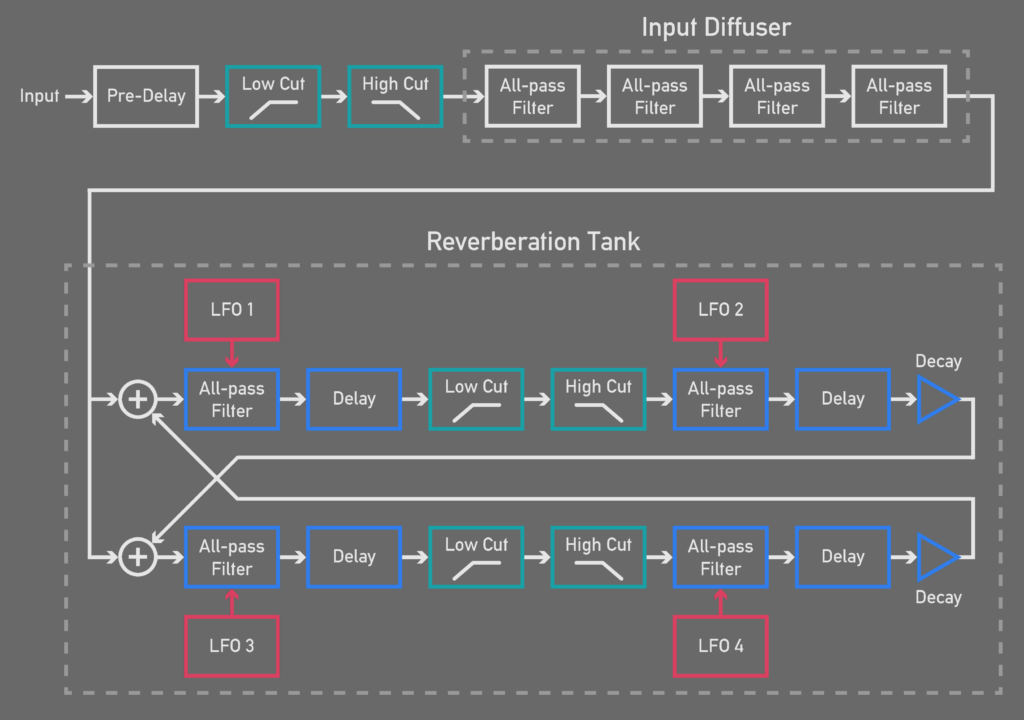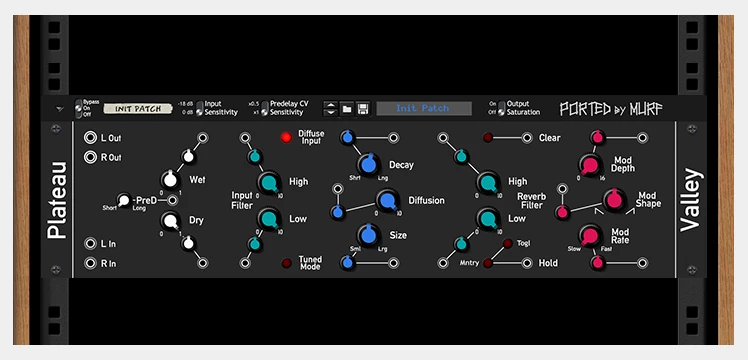Valley Plateau

Valley Plateau is a lush plate reverb rack extension for Reason based on the famous Dattorro (1997) design, and is designed to make a dry, lifeless patch sound lush, deep and spacious. However, unlike other reverberators, Valley Plateau attempts to go beyond, providing a wide variety of control combinations and options.
This is an authorised port of the popular module “Plateau” by Dale Johnson for the VCV Rack ecosystem.
User Guide
All of the controls on Plateau have CV inputs available allowing for full automation of all parameters.
Knobs
- Dry & Wet: Control the levels of the original and reverberant signals.
- PreD: Pre-delay. Determines the delay for when the original signal is fed into the reveberator. Ranges from 0 to 500ms.
- Low and High: Input and reverberator filters.
- Size: Sets the overall delay time and apparent ‘size’ of the reverb. Ranges from very short to extremely long.
- Diffusion: Controls how diffused and smeared the reverb is. No diffusion results in audible echoes.
- Decay: Sets the speed at which the signal decays over time. The maximum setting results in a long reverb that evolves over time into a very slowly dying cloud of sound.
- Diffuse Input: Enages the input diffusion stage that pre-diffuses and smears the signal before reverberation. Bypassing the stage sharpens the input signal.
- Tuned Mode: Shortens the delay times and tunes the all-pass filters to 1V/Oct so that the reverb can be ‘played’.
Buttons
- Togl: Toggles the decay of the reverb to infinite so that it will continuously reverberate.
- Mntry: Momentarily sets the decay of the reverb to infinite so that it will continuously reverberate.
- Clear: Purges the reverberator. Useful for creating gated reverb effects, or diminishing complete chaos.
Included Patches
There is a myriad of patches included, contributed by the wonderful community at Reason Talk forums.
How it works
Valley Plateau is based upon the popular Dattorro (1997) digital plate reverb design. The flow diagram below shows a simplified version of the algorithm.

The audio is initially pre-delayed and equalised before passing through the ‘Input Diffuser’ which smears and diffuses the signal. In Plateau, there is the option to bypass this stage.
Next, the diffused signal is passed into the ‘Reverberation Tank’ which is two chains of filters arranged in parallel. The chains are fed into each other to continuously diffuse the signal and build up a dense reverberation. The reverb decays over time thanks to the equalisation and decay stages after each chain. The left and right output signals are extracted from this tank at several tap points (not shown).
Dattorro (1997) found that unpleasant ringing can build up over time. To combat this, the delay times of the all-pass filters in the tank are subtly modulated by low frequency oscillators (LFOs). This modulation changes the resonant frequency of the reverberator over-time to suppress the ringing. This also slowly changes the reflection pattern so that it appears to continuously vary. With moderate modulation, this results in an audible pitch shifting.
Download Valley Plateau for ReasonStudios Reason here
The original manual is available here
© 2020 Dale Johnson

 D5 Creation
D5 Creation